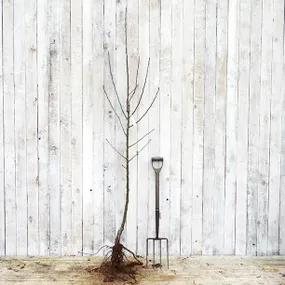Greensleeves Apple Trees
Honest Delivery Prices- Eating and Juicing: medium sharp flavour.
- Spur bearer (Good for cordons & espaliers)
- Self fertile
- Pollinator
- Pollination Group B
- Crops in August/September.
- RHS Award of Garden Merit
Recommended extras
Description
Malus domestica Greensleeves - Eating Apples
Greensleeves is one of the more decorative fruit trees, carrying glorious blossom and fresh green disease resistant leaves in abundance. The fruit is mid-sized, and tastes fantastic straight off the tree. The apples ripen green, but do not taste like any French apple you have ever tried. Also excellent for cider.
Browse our range of apple trees or see the full variety of fruit trees.
Apple Tree Pollination guide for Greensleeves
Greensleeves is a self-fertile tree but needs a suitable pollinator to crop well. It flowers early and so will go well with any of the early or mid season trees in the pollinator or fertile categories of the Apple Tree Pollination table. Alternatively, Crab apple trees are superb for pollinating a whole orchard across the seasons; the best species in our books are the John Downie and Golden Hornet crab trees.
Rootstocks for Greensleeves
We use MM106 rootstocks for all the apple trees- we sell. These are the UK standard for medium sized trees, designed to be pruned by gardeners at home and produce enough fruit to be a decent orchard tree. MM106 has good resistance to dry periods - yes they do happen once your tree is established. A mature Greensleeves, grown as a half-standard will be about 4 metres - 15 feet tall and if trained as a bush should give 3 metres of fruit laden branches.
Planting Instructions
Lift the turf (if any) in a circle of about 100cms (3ft) diameter. Soak the tree roots in water for about an hour before planting.
Dig a square hole that is about 20cms comfortably wider in both directions than the tree's roots but only a little (maybe) 5 cm deeper. Do not plant less than 30cms from any wall.
Hammer in a tree stake off centre in the direction of the prevailing wind if the tree needs support (so the wind blows the tree away from the stake).
Loosen the soil in the bottom of the hole and add or take away until, when the tree roots are on it, the soil mark on the trunk is at the level of the ground outside the hole. Keep the graft (if there is one) at least 5cms higher than the surrounding soil. Tie the tree to the stake and position ready for planting. Wet the roots again, sprinkle Rootgrow on them and return the soil from the hole, firming it down every few centimetres.
Water well, mulch the circle in the grass and water weekly thereafter through the first summer. Use a tree guard if you have "vermin"

 Img 1.webp)
 Img 1.webp)
 Img 2.webp)
 Img 3.webp)
 Img 4.webp)

